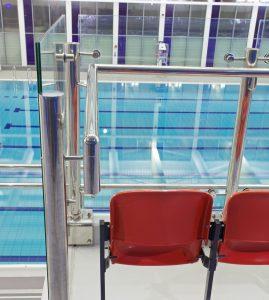Balustrade Considerations for Leisure Facilities
Posted on 22nd May 2018Balustrading within pool and leisure environments is more susceptible to corrosion and tea staining, which could compromise the compliance of your system. Ultimately, this could leave your project exposed to a potential health and safety risk.
After being asked for advice by a main contractor, Business Development Manager, Garth Boyt, put together the following considerations when selecting a balustrade system for a leisure project.
Stainless Steel Grade and Finish
It is important to ensure the correct grade of stainless steel is specified for the buildings purpose and the surface to be a bright finish. Standard brushed finishes can retain moisture and, even with regular cleaning, are at risk of tea staining and corrosion.
Delta Balustrades recommend use of nTechnology as an applied finish. nTechnology considerably reduces the adhesion that chlorides have to the surface, and therefore reduces the cleaning requirements of the finished product. Although regular cleaning is still required, far fewer chemicals are needed to achieve a pristine finish.
Fixings specifications are critical, along with designing the balustrades in such a way as to minimise visible fixings. The use of core drilling pockets instead of exposed fixing plates can be an effective solution to reduce risk.
Glass Specification
In a pool environment, monolithic toughened glass would be a risk due to its characteristics should it fail; the glass will shatter into relatively harmless pieces that no longer support a load or act as a barrier but would mean the pool would have to be emptied and cleaned at a large cost to the end user.
Toughened laminated glass, which has been heat soak tested, is important to specify.
Heat-soak testing is a destructive test for the presence of nickel sulphide inclusions. It involves placing the toughened glass in an oven and heating it to a temperature of 290oC. The glass is kept at this temperature for a period long enough to fracture a large proportion of any panes that might otherwise fail in service. Heat-soak testing achieves a conversion rate of 90% – 95%.
Delta Balustrade’s systems only use bolt-though glass lugs, which never carry any risk of slipping or falling, to ensure compliance to regulations.
Balustrade Loadings
Leisure centres and swimming pool environments have many areas which are susceptible to overcrowding and these requirements need to be considered from an early stage as a potential risk.
BS6180 provides guidance on loadings and input from Building Control to confirm the loading requirements for your project will be necessary.
In addition, some spectator seating areas are covered by the Green Guide for Safety at Sports Grounds, which provide specific guidance about balustrade loadings in front and adjacent to seating areas and gangways.
Loadings can make a difference to the design and fixing of your balustrade system, so early confirmation of crowd loadings is important to save costly changes later.
As a requirement, balustrades must be accredited to the BSI Kitemark for Barriers and structural calculations provided to ensure compliance.
Further Considerations
- Balustrade height: are additional heights required to any areas? For example, if a balustrade is positioned on an upstand, is a height of 1100mm required from the top of the upstand?
- Earthing Connections: clarify whether your project environment has an earthing connection you need to consider.
- Sequencing of fixings: consider the floor finish for your balustrade fixings, for example most pool environments have tiled floor finishes.
- Access gates: Gate latches and hinges need to be suitable for the environment, as more complex parts they can be difficult to maintain.
Balustrades are recognised as a safety critical structure and choosing a manufacturer with experience and products suitable to these environments is important. A balustrade failure in a leisure environment, often frequented by children and families, could have catastrophic consequences.
From experience, early engagement with the design team is valuable to ensure that there are solutions to these challenges and risks and to eliminate further risks and costs once on site.

